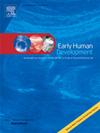使用婴儿运动表现测试预测极早产儿的神经发育
IF 2
3区 医学
Q2 OBSTETRICS & GYNECOLOGY
引用次数: 0
摘要
早产儿(VPT)神经发育障碍的风险增加。婴儿运动表现测试(TIMP)是一种用于评估婴儿大运动技能的评估方法,然而,对其预测VPT婴儿准确性的理解是有限的。目的确定在足月龄(TEA)和3个月矫正月龄(CA)评估TIMP的准确性,以识别VPT婴儿在12个月矫正月龄时的运动或认知障碍。方法本前瞻性观察队列研究招募202例胎龄≤31周的新生儿。在TEA和CA 3个月时进行TIMP。在CA 12个月时进行以下神经发育评估;阿尔伯塔婴儿运动量表(AIMS),神经感觉运动发展评估(NSMDA)和Bayley婴幼儿发展量表第三版(Bayley III)。结果TIMP在所有四个结局指标上的特异性高于敏感性。使用TEA的截断值≤-0.5,TIMP z-评分显示NSMDA(灵敏度61%,特异性50%),AIMS(灵敏度59%,特异性50%)和Bayley III(灵敏度56%,特异性51%)的运动结果的敏感性和特异性较低。曲线下面积分析显示,在3个月时评估的TIMP比在12个月时评估的TIMP更准确。结论在TEA和3个月时评估的TIMP正确地识别了大多数没有运动和认知障碍的VPT婴儿。然而,它遗漏了在CA 12个月时出现不良神经发育结果的VPT婴儿。本文章由计算机程序翻译,如有差异,请以英文原文为准。
Predicting neurodevelopment in very preterm infants using the Test of Infant Motor Performance
Background
Infants born very preterm (VPT) are at increased risk of neurodevelopmental impairments. The Test of Infant Motor Performance (TIMP) is an assessment used to evaluate an infant's gross motor skills, however, understanding of its predictive accuracy in VPT infants is limited.
Aims
To determine the accuracy of the TIMP assessed at term equivalent age (TEA), and 3 months corrected age (CA), to identify motor or cognitive impairment at 12 months CA in VPT infants.
Method
This prospective observational cohort study recruited 202 infants born at <31wks gestational age (GA). At TEA and 3 months CA the TIMP was performed. At 12 months CA the following neurodevelopmental assessments were conducted; Alberta Infant Motor Scale (AIMS), Neurological Sensory Motor Development Assessment (NSMDA) and Bayley Scale of Infant and Toddler Development 3rd edition (Bayley III).
Results
The TIMP had higher specificity than sensitivity across all four outcome measures. Using a cut off-of ≤ -0.5 at TEA, TIMP z-scores demonstrated low sensitivity and specificity for motor outcomes on the NSMDA (sensitivity 61 %, specificity 50 %), AIMS (sensitivity 59 %, specificity 50 %) and Bayley III (sensitivity 56 %, specificity 51 %). Area under the curve analyses showed that the TIMP assessed at 3 months had greater accuracy than at TEA in identifying neurodevelopmental impairments at 12 months CA.
Conclusions
The TIMP assessed at TEA and 3 months CA correctly identified the majority of VPT infants without motor and cognitive impairments. However, it missed VPT infants who developed adverse neurodevelopmental outcomes by 12 months CA.
求助全文
通过发布文献求助,成功后即可免费获取论文全文。
去求助
来源期刊

Early human development
医学-妇产科学
CiteScore
4.40
自引率
4.00%
发文量
100
审稿时长
46 days
期刊介绍:
Established as an authoritative, highly cited voice on early human development, Early Human Development provides a unique opportunity for researchers and clinicians to bridge the communication gap between disciplines. Creating a forum for the productive exchange of ideas concerning early human growth and development, the journal publishes original research and clinical papers with particular emphasis on the continuum between fetal life and the perinatal period; aspects of postnatal growth influenced by early events; and the safeguarding of the quality of human survival.
The first comprehensive and interdisciplinary journal in this area of growing importance, Early Human Development offers pertinent contributions to the following subject areas:
Fetology; perinatology; pediatrics; growth and development; obstetrics; reproduction and fertility; epidemiology; behavioural sciences; nutrition and metabolism; teratology; neurology; brain biology; developmental psychology and screening.
 求助内容:
求助内容: 应助结果提醒方式:
应助结果提醒方式:


